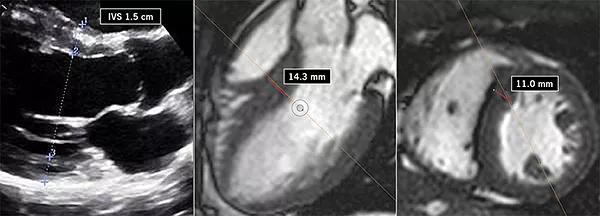Echo findings in young athletes are not always what they seem

Cleveland Clinic is a non-profit academic medical center. Advertising on our site helps support our mission. We do not endorse non-Cleveland Clinic products or services. Policy
A white male high school basketball player undergoes an ECG and echocardiogram after presenting with atypical chest pain. Although the ECG is unremarkable, he is disqualified from competitive sports because of concern for hypertrophic cardiomyopathy (HCM) after the echo reveals septal wall thickness of 1.5 cm. He has no family history of HCM.
He comes to Cleveland Clinic’s Sports Cardiology Center for a second opinion. The septal wall measurements are confirmed on echocardiogram (left image below). While up to 18 percent of African-American athletes have septal wall thickness greater than 12 mm, this finding is unusual in a white athlete. However, diastolic function and longitudinal strain are normal (see systolic strain profile at bottom of post).

He performs well on a metabolic stress test (VO2 max is 64.3 mL/kg/min), and MRI reveals no scar and a normal mitral valve apparatus. Close evaluation of the MRI reveals that the septal measurement from long-axis view was overestimated due to a tangential cut through the septum and inclusion of right ventricular trabeculation (middle image above). The true septal measurement is determined to be 11 mm (right image above). The collective findings are believed to be related to “athlete’s heart,” and the patient is allowed to return to play.

The patient’s systolic strain profile.
For more on athlete’s heart, see this companion Consult QD post .

Further acute testing not needed if ECG and high-sensitivity troponin are negative

Scott Cameron, MD, PhD, also brings wide-ranging research interests to bear

Pioneering U.K. vascular surgeon joins Cleveland Clinic

AHA statement is first comprehensive document on perioperative stroke reduction

Recognition reflects prioritization of long-term patient outcomes

Recommendations help distinguish exercise-induced remodeling from pathology

JACC review highlights factors unique to women, ways to tailor management

Pushing the envelope in ablation of atrial fibrillation, ventricular tachycardia